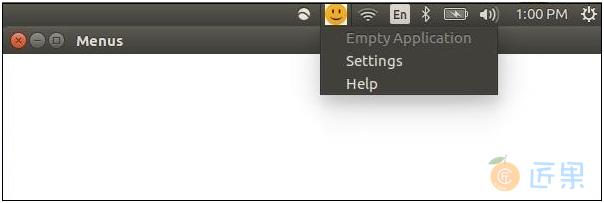系统托盘是应用程序窗口之外的菜单。 在MacOS和Ubuntu上,它位于屏幕的右上角。 在Windows上,它位于右下角。 我们可以使用Electron为系统托盘中的应用程序创建菜单。
创建一个新的main.js 文件并将以下代码添加到其中。 准备好png文件用于系统托盘图标。
const {app, BrowserWindow} = require('electron')
const url = require('url')
const path = require('path')
let win
function createWindow() {
win = new BrowserWindow({width: 800, height: 600})
win.loadURL(url.format ({
pathname: path.join(__dirname, 'index.html'),
protocol: 'file:',
slashes: true
}))
}
app.on('ready', createWindow)
设置基本浏览器窗口后,我们将创建一个包含以下内容的新index.html 文件:
<!DOCTYPE html>
<html>
<head>
<meta charset = "UTF-8">
<title>Menus</title>
</head>
<body>
<script type = "text/javascript">
const {remote} = require('electron')
const {Tray, Menu} = remote
const path = require('path')
let trayIcon = new Tray(path.join('','/home/ayushgp/Desktop/images.png'))
const trayMenuTemplate = [
{
label: 'Empty Application',
enabled: false
},
{
label: 'Settings',
click: function () {
console.log("Clicked on settings")
}
},
{
label: 'Help',
click: function () {
console.log("Clicked on Help")
}
}
]
let trayMenu = Menu.buildFromTemplate(trayMenuTemplate)
trayIcon.setContextMenu(trayMenu)
</script>
</body>
</html>
我们使用Tray子模块创建了托盘。 然后,我们使用模板创建了一个菜单,并进一步将菜单附加到托盘对象。
使用以下命令运行应用程序:
$ electron ./main.js
运行上述命令时,请检查系统托盘中是否有您使用的图标。 我的笑脸用于我的申请。 上面的命令将生成以下输出:
下一节:Electron仅为MacOS提供本机通知API。 所以我们不打算使用它,而是使用名为node-notifier的npm模块。 它允许我们在Windows,MacOS和Linux上通知用户。
